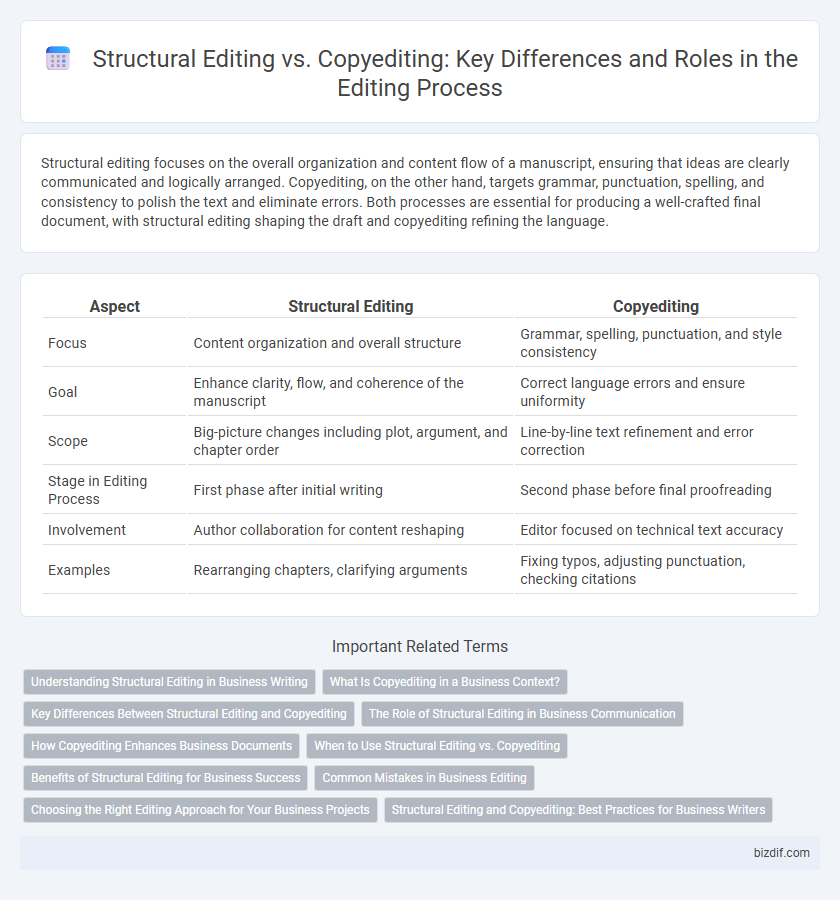Structural editing focuses on the overall organization and content flow of a manuscript, ensuring that ideas are clearly communicated and logically arranged. Copyediting, on the other hand, targets grammar, punctuation, spelling, and consistency to polish the text and eliminate errors. Both processes are essential for producing a well-crafted final document, with structural editing shaping the draft and copyediting refining the language.
Table of Comparison
| Aspect | Structural Editing | Copyediting |
|---|---|---|
| Focus | Content organization and overall structure | Grammar, spelling, punctuation, and style consistency |
| Goal | Enhance clarity, flow, and coherence of the manuscript | Correct language errors and ensure uniformity |
| Scope | Big-picture changes including plot, argument, and chapter order | Line-by-line text refinement and error correction |
| Stage in Editing Process | First phase after initial writing | Second phase before final proofreading |
| Involvement | Author collaboration for content reshaping | Editor focused on technical text accuracy |
| Examples | Rearranging chapters, clarifying arguments | Fixing typos, adjusting punctuation, checking citations |
Understanding Structural Editing in Business Writing
Structural editing in business writing focuses on organizing content for clarity, coherence, and logical flow, ensuring the message aligns with the intended purpose and audience needs. It addresses larger issues such as paragraph sequencing, section relevance, and overall document framework, improving readability and impact. This differs from copyediting, which targets grammar, punctuation, and syntax details to polish the text at a micro level.
What Is Copyediting in a Business Context?
Copyediting in a business context involves reviewing text for grammar, punctuation, spelling, and consistency to ensure clarity and professionalism in company communications. It focuses on correcting errors and improving readability without altering the overall structure or content of the document. This process strengthens brand voice and enhances the effectiveness of marketing materials, reports, and internal documents.
Key Differences Between Structural Editing and Copyediting
Structural editing focuses on the overall organization, content flow, and coherence of a document, ensuring that the narrative or argument is logically structured and effectively communicated. Copyediting, on the other hand, targets sentence-level details such as grammar, punctuation, spelling, and consistency to enhance readability and correctness. The key differences lie in scope and depth: structural editing reshapes large portions of the text for clarity and impact, while copyediting refines the surface elements for precision and polish.
The Role of Structural Editing in Business Communication
Structural editing plays a crucial role in business communication by organizing content for clarity, flow, and coherence, ensuring the message aligns with strategic objectives. This editing phase involves reshaping sections, refining arguments, and enhancing overall readability to engage the target audience effectively. By prioritizing structural editing before copyediting, businesses communicate more persuasively and professionally, establishing credibility and fostering stronger stakeholder relationships.
How Copyediting Enhances Business Documents
Copyediting enhances business documents by ensuring clarity, consistency, and accuracy in grammar, punctuation, and style, which strengthens professional communication. It refines sentence structure and corrects typographical errors, making documents more polished and easier to understand. This precise attention to detail helps maintain the company's credibility and supports effective information delivery to clients and stakeholders.
When to Use Structural Editing vs. Copyediting
Structural editing is essential during the early stages of manuscript development when major revisions to plot, organization, or content flow are needed to enhance clarity and coherence. Copyediting is more appropriate during the final stages, focusing on correcting grammar, punctuation, spelling, and formatting errors to ensure polished and professional text. Choosing the right type depends on whether the priority is to improve the overall structure or to refine language and technical accuracy.
Benefits of Structural Editing for Business Success
Structural editing enhances overall content clarity and flow, ensuring messages align with business goals and audience expectations. This type of editing identifies and corrects organizational issues, improving readability and engagement, which leads to stronger brand communication. Investing in structural editing fosters professional, persuasive materials that drive customer trust and boost conversion rates.
Common Mistakes in Business Editing
Common mistakes in business editing often arise from confusing structural editing with copyediting, leading to overlooked issues in content organization and message clarity. Structural editing addresses the overall framework, coherence, and logical flow of business documents, while copyediting focuses on grammar, punctuation, and style accuracy. Neglecting the distinction may result in polished language but disjointed presentations, reducing the effectiveness of corporate communication.
Choosing the Right Editing Approach for Your Business Projects
Structural editing addresses the overall organization, flow, and coherence of your business documents, ensuring ideas are logically presented and effectively communicated. Copyediting focuses on correcting grammar, punctuation, spelling, and consistency to polish the text for clarity and professionalism. Selecting the appropriate editing approach depends on your project's stage and goals--structural editing is ideal for early drafts needing content refinement, while copyediting suits finalized texts requiring error-free precision.
Structural Editing and Copyediting: Best Practices for Business Writers
Structural editing enhances overall content organization, clarity, and flow by addressing big-picture issues such as logical structure, coherence, and paragraph arrangement. Copyediting focuses on refining grammar, punctuation, spelling, and style consistency to ensure error-free and polished text. Business writers benefit from combining structural editing's content reorganization with copyediting's attention to detail to produce clear, professional, and impactful documents.
Structural editing vs copyediting Infographic

 bizdif.com
bizdif.com